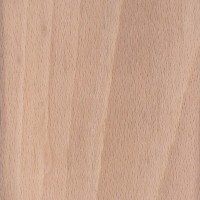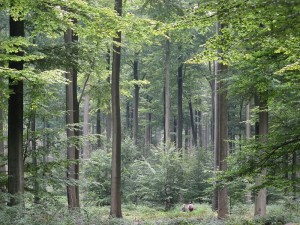European Beech, presented by The Wood Database.
Trade Name: Beech, European beech.
Genus: Fagus sylvatica
Janka Hardness (pounds-force): 1450
Donar Reiskoffer took this picture. Upon close inspection, two people in somewhat close proximity to Mr. Reiskoffer can be seen in the dense undergrowth.
Description: Very pale tan to warmer browns. The European beech is a large deciduous forest tree. Veneers are darker colored, as a result of the steaming process required for this cut. Flatsawn surfaces are quite bland, while the quarter-sawn millruns are generally speckled, or flecked. European beech is the most popular hardwood in the United Kingdom.
Location: Central Europe, specifically: Norway, Denmark, Germany, France, Czech Republic, Slovakia, Slovenia, Spain, Italy, Bosnia-Herzegovina, Bulgaria, Romania.
Common Aliases: Common beech, English beech, French beech, Varlig bok, Rod bok, Yugoslavian beech, European steamed beech.
Performance: Very hard, but can be dimensionally unstable. Beechwood is a utility wood, and has widespread application as a fuel wood. Finishing qualities are good. Beech is easy to work (with the exception of veneer sampling), planes and nails all right, and is suitable for joinery. Beech is an above average utility hardwood.
Common Uses: Lumber, flooring, furnishing, cabinetry, piano pinblocks, plywood, veneers, turnings.
From: The Wood Database:
Common Name(s): European Beech
Scientific Name: Fagus sylvatica
Distribution: Europe
Tree Size: 100-130 ft (30-40 m) tall, 3-5 ft (1-1.5 m) trunk diameter
Average Dried Weight: 45 lbs/ft3 (720 kg/m3)
Basic Specific Gravity: .53
Hardness: 1,450 lbf (6,460 N)
Rupture Strength: 15,970 lbf/in2 (110,140 kPa)
Elastic Strength: 2,075,000 lbf/in2 (14,310 MPa)
Crushing Strength: 8,270 lbf/in2 (57.0 MPa)
Shrinkage: Radial: 5.7%, Tangential: 11.6%, Volumetric: 17.3%, T/R Ratio: 2.0

